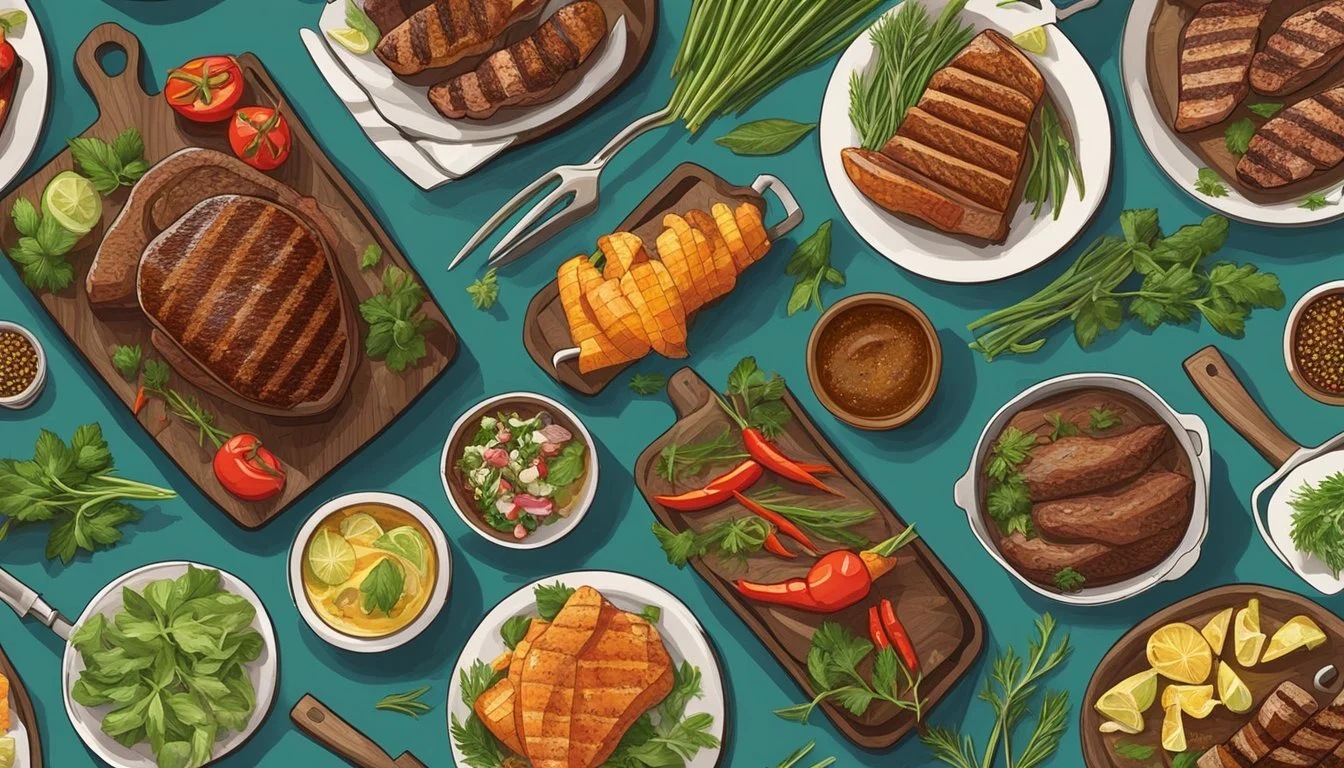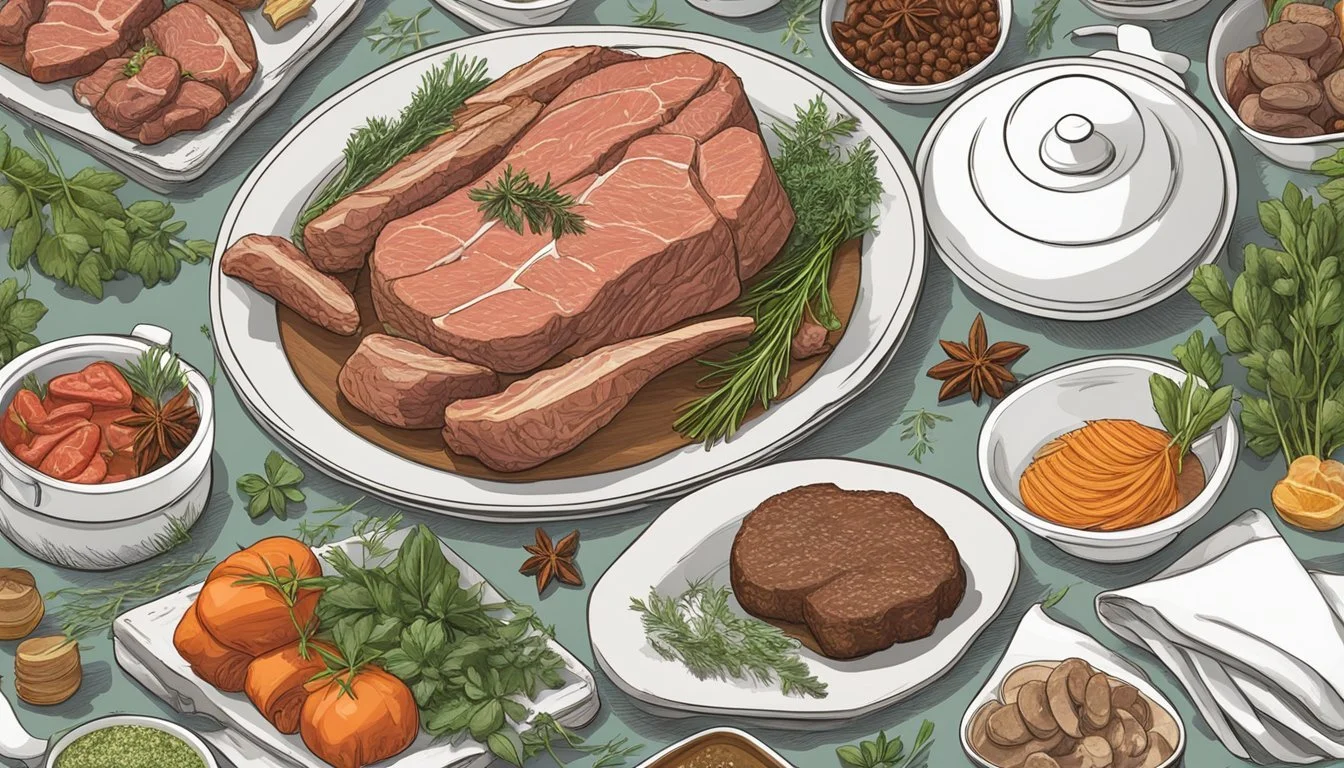The Carnivore Diet for Chefs
Unleashing Culinary Creativity Solely with Meat
The carnivore diet has emerged as a polarizing yet intriguing trend within the culinary world. Rooted in the concept of consuming animal products exclusively, this meat-centered way of eating challenges chefs to rethink traditional approaches to meal preparation and menu development. The diet underscores a return to ancestral eating patterns, focusing on meats, fish, eggs, and dairy while excluding plant-based foods. With a growing interest in diets that reduce carbohydrate intake, the carnivore diet offers a distinct framework for chefs to explore culinary innovation with a narrowed ingredient spectrum.
In professional kitchens, the carnivore diet can transform constraints into a test of creativity. Chefs are called upon to showcase their skills by developing diverse and appetizing menus centred around meat. This requires an in-depth understanding of meat preparation, seasoning, and the various cuts available, as well as an appreciation for the subtle nuances that different cooking methods can introduce to the flavor and texture of animal products. The emphasis on simplicity and purity of ingredients prompts chefs to focus on quality and sourcing, perhaps considering local and grass-fed animal options to elevate the dining experience.
The challenge and allure of the carnivore diet lie in its simplicity, and its potential to inspire chefs to approach their craft with renewed inventiveness. Culinary professionals must navigate the diet's restrictions by offering dishes that not only adhere to the rigors of carnivory but also delight the palate. As the diet gains traction among a subset of food enthusiasts, the hospitality and restaurant industries stand at the cusp of delivering remarkable and satisfying experiences to those who choose, whether for health or personal reasons, to dine solely on animal-based fare.
Fundamentals of the Carnivore Diet
The Carnivore Diet focuses on the consumption of exclusively animal products, emphasizing the importance of protein and fat as core components of daily nutritional intake.
Principles and Benefits
The fundamental principle of the Carnivore Diet is the exclusive consumption of animal products such as meat, fish, eggs, and certain dairy. It eliminates all plant-based foods. This diet is centered around protein and fat, which can contribute to satiety and potentially aid in weight loss. Proponents argue that the diet can lead to improvements in body composition due to its high protein content, which is essential for muscle repair and growth.
Animal Products: Meat, fish, eggs, high-fat dairy
Protein: Serves as the building block for muscles
Fat: Used as a primary energy source, with a focus on saturated fats
Common Misconceptions
All fats are harmful: It's often thought that the high intake of fats on the Carnivore Diet is detrimental to heart health. However, consuming a balance of different fats is key and there is no singular approach that suits everyone.
It's just meat: While meat is a staple, the diet can include other animal products like eggs and specific dairy products.
It's critical to understand the complexity and individual nature of diet and nutrition, recognizing that the Carnivore Diet may not be suitable for everyone and that consultation with healthcare providers is recommended for personalized advice.
Nutritional Profile
In the carnivore diet, the nutritional profile focuses solely on animal-based foods, providing ample protein and fats which are essential for bodily functions and overall health.
Protein Sources in the Carnivore Diet
Protein is a fundamental component of the carnivore diet, essential for muscle repair, enzyme creation, and numerous other bodily functions. The primary sources of protein in this diet are meat and eggs.
Beef: Rich in creatine and B vitamins, offering a complete amino acid profile.
Pork: Another excellent source of complete protein.
Organ Meat: High in protein and dense in nutrients like vitamin A, B vitamins (particularly B12), and iron.
Fish: Offers lean protein and omega-3 fatty acids, especially in fatty fish like salmon and mackerel.
Each of these animal products not only contributes a rich amount of essential amino acids but also provides a variety of textures and flavors for culinary exploration.
Fats and Their Importance
Fats play a crucial role in the carnivore diet, providing energy and aiding in the absorption of fat-soluble vitamins. They are also vital for the proper function of the brain and other organs.
Saturated Fat: Found in animal products, it remains a controversial nutrient but is necessary for the body in moderation.
Eggs: A versatile ingredient, they provide high-quality fats that can add richness to any dish.
Fish: Particularly oily fish like sardines and sea bass are excellent sources of omega-3 fatty acids, which are essential for heart health.
Lard: A traditional cooking fat that can be used for frying and baking, contributing both flavor and a healthy source of fat.
Understanding the balance and types of fats is important for maintaining health on a carnivore diet and provides chefs with a range of options for enhancing the taste and nutritional value of their dishes.
Discover the endless possibilities of buying lard online!
Carnivore Diet Food List
This section is dedicated to the rich variety of foods that can be included in a chef’s carnivore diet repertoire, focusing on meat, seafood, and animal byproducts.
Meat Varieties
In the carnivore diet, meat serves as the cornerstone, fulfilling nutritional needs and providing culinary diversity. Quality and correct preparation of the following meats are essential:
Beef: Steaks, ribs, roasts, and ground beef.
Pork: Chops, bacon (how long does bacon last?), ham, and tenderloin.
Lamb: Racks, shanks, and ground lamb.
Chicken: Breast, thighs, drumsticks, and wings.
Game: Such as bison and elk, providing unique flavors.
Organ Meats: Nutrient-dense options including liver and kidney.
Seafood Selection
Seafood stands as a pivotal part of the diet, delivering vital nutrients and variety:
Fish: Salmon, mackerel, and sardines are popular for their fatty acid content.
Seafood: Shrimp, lobster (What wine goes well with lobster?), and other shellfish expand the diet's flavor profile.
Dairy and Eggs
Although a strictly carnivorous approach emphasizes meats, dairy and eggs can be included for their richness and texture:
Eggs: A versatile ingredient used in various culinary methods.
Milk: Occasional use, preferably full-fat or raw, depending on tolerance.
Butter and Cream: Excellent for cooking and adding flavor to dishes.
Cheese: Aged or soft cheeses, included as a taste enhancer or a recipe component.
Meal Planning and Recipes
Proper meal planning on a carnivore diet ensures a chef can create diverse dishes while adhering to the dietary restrictions. Recipe selection often revolves around a limited set of ingredients, focusing on meats such as steak, bacon, and ground beef, alongside items like bone broth to enhance flavor and nutritional value.
Basic Meal Planning
When planning meals for a carnivore diet, one must consider nutritional balance and variety to prevent boredom. Steaks and bacon serve as rich sources of protein and fat, suitable for breakfast or lunch (What wine goes well with lunch?), while ground beef provides a flexible base for many recipes, from burgers to meatballs. Bone broth can be incorporated for a nourishing drink or soup base, offering a cozy and warming element to the diet.
A sample Weekly Meal Plan could include:
Monday: Breakfast - Scrambled eggs with bacon; Lunch - Ribeye steak; Dinner - Beef shank in bone broth
Tuesday: Breakfast - Pork sausages (What wine goes well with pork sausages?) ; Lunch - Ground beef patties; Dinner - Bacon-wrapped chicken thighs (What wine goes well with chicken thighs?)
Wednesday: Breakfast - Bone broth with marrow; Lunch - Liver and onions; Dinner - Slow-cooked pork shoulder
Carnivore Diet Recipes
Recipes within the carnivore diet are crafted to be simple yet satisfying, focusing on the inherent flavors of the meat. Below are examples showcasing how to utilize steak, bacon, and ground beef in culinary creations:
Steak
Seared Ribeye: Sear a ribeye steak to the desired level of doneness, seasoned with salt, and let it rest before serving to ensure juiciness.
Bacon
Bacon Weave: Create a lattice of bacon strips and bake until crispy, offering a texture-rich base for dishes or as a standalone snack.
Ground Beef
Carnivore Meatballs: Mix ground beef with salt and egg yolks, form into balls, and cook in bone broth for a simple, hearty meal.
Incorporating these techniques and ingredients allows for a variety of meals throughout the week while maintaining a commitment to the carnivore diet principles.
Health Considerations
When considering the carnivore diet, chefs must understand the health implications, both positive and negative. This diet, consisting solely of animal products, can have significant effects on chronic conditions and may lead to various risks and side effects due to its restrictive nature.
Benefits for Chronic Conditions
Heart Disease and Obesity: Some proponents argue that by eliminating carbohydrate-rich foods, the carnivore diet could reduce markers of inflammation and aid in the management of heart disease and obesity. They suggest that a diet high in animal fats and proteins may lead to improved satiety, potentially contributing to weight loss and a decreased risk of heart disease.
Type 2 Diabetes: There is evidence to suggest that low-carbohydrate diets can lower blood sugar levels, providing benefit for individuals with type 2 diabetes. The all-meat diet, being extremely low in carbohydrates, may help in stabilizing blood glucose levels and increasing insulin sensitivity.
Potential Risks and Side Effects
Nutrient Deficiencies: Exclusively consuming animal products bears a risk of nutrient deficiencies. Vital nutrients predominantly found in plant foods, such as fiber, Vitamin C, and certain minerals, may be inadequate in a carnivore diet, potentially leading to health issues over time.
Digestive Health: A lack of dietary fiber can lead to constipation and other digestive issues.
Energy Levels: Initially, individuals may experience a drop in energy as the body adjusts from using carbohydrates to fats as its primary energy source.
Chronic Disease Risks: A diet high in red and processed meats has been associated with an increased risk of heart disease and certain cancers, although the causal relationship in the context of a carnivore diet is not fully established.
Chefs devising menus around the carnivore diet must do so with awareness of these health considerations to ensure a responsible approach to their culinary offerings.
Lifestyle and Sustainability
Exploring the carnivore diet reveals intersecting pathways of daily lifestyle choices and the pursuit of sustainable meat consumption practices amidst culinary enthusiasts.
Carnivore Diet in Daily Life
For those adopting a carnivore diet, daily meals consist exclusively of animal products. This lifestyle choice significantly narrows the spectrum of food variety, requiring a creative approach to meal planning to ensure nutritional adequacy and culinary satisfaction. Individuals often prioritize high-quality meats such as grass-fed beef and pasture-raised poultry to align with both health and ethical considerations.
Common Foods in the Carnivore Diet:
Red meats (beef, pork, lamb)
Poultry (chicken, turkey)
Fish and seafood
Eggs
Dairy products (limited to high-fat options like cheese and butter)
Sustainable Meat Consumption
Sustainable meat consumption within the carnivore community emphasizes the environmental impact of meat sourcing and production. Advocates encourage practices like supporting local farms and choosing grass-fed options to reduce the carbon footprint. The conversation also touches on responsible butchery techniques that aim to minimize waste.
Strategies for Sustainable Meat Sourcing:
Local: Support nearby farms to lower transportation emissions.
Grass-Fed: Choose meats from animals raised on open pastures.
Nose-to-Tail: Use the whole animal to reduce waste.
These guiding principles enable individuals to maintain a carnivore diet while being mindful of their environmental footprint.
Scientific Evidence
The scientific exploration into the carnivore diet has presented an array of studies and expert opinions. This section will focus on the rigorous examination of its effects and insights from knowledgeable figures.
Studies on Carnivore Diet Effects
Clinical Research: A closer look at the available research reveals a mixed set of results. Some studies suggest that diets high in animal proteins and fats, which are characteristic of the carnivore diet, can lead to improved markers in metabolic health, such as weight loss and better blood glucose control. However, these studies often highlight the need for further long-term research, as the majority of data is derived from short-term trials.
Nutrient Intake: Given the all-meat focus, the diet is rich in certain nutrients such as iron, vitamin B12, and protein. Yet, it inherently lacks fiber and vitamin C, among other nutrients typically found in plants, raising questions about its long-term sustainability and potential for nutrient deficiencies.
Expert Opinions and Testimonials
Prominent Advocates: Prominent figures such as Dr. Shawn Baker, an orthopedic surgeon, have been vocal in their advocacy for the carnivore diet. Baker cites improvements in his own health and athletic performance, and has contributed to the conversation with anecdotal evidence and personal testimonials.
Nutritional Perspectives: Experts such as Mikhaila Peterson have also shared their personal successes with the carnivore diet, often discussing the resolution of autoimmune issues and other health problems. Yet, the scientific community remains cautious, pointing out that personal testimonials should be interpreted with caution and not be seen as a substitute for controlled, peer-reviewed scientific research.
Health professionals emphasize the significance of individualized dietary approaches because responses to diets can vary greatly among individuals. They also recommend that anyone considering the carnivore diet should consult with healthcare providers to discuss its potential risks and benefits.
Expanding Culinary Creativity
In the realm of the carnivore diet, chefs explore the depth and breadth of culinary creativity with a focus on meat-based dishes. They achieve this through the application of innovative cooking techniques and the reinvention of desserts to align with the diet's restrictions.
Innovative Cooking Techniques
Chefs adept in carnivore diet cuisine employ a range of cooking techniques to accentuate the flavors and textures of meat. Dry-aging is a process that intensifies beef flavor and tenderizes the meat, elevating a simple steak to gourmet status. Sous-vide cooking, where meat is vacuum-sealed and cooked in a water bath at precise temperatures, results in consistently perfect doneness. Experimenting with different cooking temperatures and times brings out unique aspects of the meat that aren't achievable through traditional methods.
Smoking meats with a variety of woods like hickory, mesquite, or applewood adds a depth of flavor that cannot be replicated by indoor cooking. The spice selection also plays a crucial role; incorporating exotic spices like sumac, ras el hanout, or Szechuan peppercorns can transform a simple cut of meat into a culinary masterpiece without the need for non-animal products.
Carnivore-Friendly Desserts
Desserts on a carnivore diet present a unique challenge due to the exclusion of traditional sweet ingredients. Chefs have risen to this challenge with creativity, utilizing elements like mascarpone, cream cheeses, and animal fats to craft indulgent, carnivore-friendly desserts. Eggs, a staple in the carnivore diet, are pivotal in creating textures and structures in desserts. They make possible a variety of dishes from mousse to custards (how long do custards last?).
The use of natural sweeteners such as monk fruit extract or erythritol, which do not impact blood sugar levels in the same way as sugar, allow for a hint of sweetness while remaining true to the principles of the carnivore diet. Innovations in this space have led to the creation of carnivore diet-compliant cheesecakes, panna cotta, and even ice creams based on animal products, satisfying the sweet tooth without plant-based ingredients.
Building a Community
Engagement and support play critical roles in thriving on the carnivore diet. Chefs and enthusiasts join forces to form a strong community centered around sharing experiences and culinary exploration.
Forums and Social Media
Forums and social media platforms have become instrumental in connecting individuals following the carnivore diet. Members often use these spaces to:
Share recipes and cooking techniques
Discuss the challenges and victories of maintaining the diet
Provide moral support and encouragement
Popular Forums and Social Networks:
Carnivore Diet Subreddit
Facebook Groups like "Zero Carb" and "Carnivore Diet"
Instagram hashtags such as #carnivorediet and #meatheals
Events and Meetups
Physical events and meetups serve as a place for community members to gather and share their passion for carnivorous cooking. They usually involve:
Cooking demonstrations and competitions
Sampling new recipes
Educational talks on nutrient balance and dietary benefits
Types of Community Events:
Event Type Purpose Cook-offs To showcase culinary skills and share innovative recipes Meal Sharing To taste and enjoy a variety of meats with fellow carnivores Workshops To educate on the nuances of meal planning on a carnivore diet
Challenges and Solutions
Embracing the carnivore diet requires culinary professionals to confront the inherent challenges of restricted ingredient use while maintaining a commitment to creativity and variety. Chefs must address cravings for non-animal products and find innovative ways to diversify their meat-based dishes.
Dealing with Cravings
When individuals transition to a carnivore diet, they may experience cravings for carbohydrates, vegetables, and fruits. Despite these challenges, solutions exist:
Substitute textures: Chefs can replicate the crunch of vegetables by using crispy meats such as bacon or pork rinds.
Flavor enhancement: Experimenting with different cooking methods, such as smoking or searing, can introduce varied flavors and potentially reduce cravings for plant foods.
Finding Variety on the Diet
A common misconception about the carnivore diet is the perceived lack of variety. However, chefs have numerous strategies to infuse diversity:
Utilize different cuts: Exploring various cuts of meat can offer a range of textures and flavors.
Type of Meat Cuts to Explore Beef Ribeye, shank, brisket Pork Shoulder, belly, loin Poultry Thigh, wing, liver
Incorporate diverse animal products: Beyond muscle meat, other animal products can provide balance and nutrient diversity.
Organs (liver, heart) are nutritionally rich.
Bone broth adds minerals and can be used in multiple ways.
Eggs and dairy (for those who tolerate it) offer additional variety in texture and flavor.
Chefs can maintain culinary innovation within the carnivore diet's boundaries by focusing on the diversity available within animal products and employing creative cooking techniques.
Carnivore Diet Myths Debunked
The carnivore diet, centered on animal products, often faces misconceptions. This section addresses common myths with factual information.
Myth 1: The Carnivore Diet Lacks Fiber
It is widely believed that the elimination of plant foods like vegetables, fruits, and grains deprives the body of necessary fiber. However, proponents argue that the body can adapt to lower fiber intake and may not require as much as once thought, especially for those with specific digestive issues.
Myth 2: Essential Nutrients Are Absent Without Plant Foods
Many assume a diet void of nuts, seeds, legumes, and vegetables is nutritionally deficient. Yet, animal products can provide a broad spectrum of vitamins and minerals, although careful selection of meats is crucial to cover all nutritional bases.
Myth 3: A High Intake of Plant Foods Is Non-negotiable
A widely held view suggests that a balanced diet must include a high consumption of plant-based foods. Although plant foods contain beneficial nutrients, the carnivore diet challenges this by proposing that animal products alone can sustain health, although this is still subject to scientific debate.
Myth 4: Carbohydrates Are Essential for Energy
Many diets emphasize the need for carbs from grains, fruits, and legumes for energy. The carnivore diet, however, relies on protein and fat for fuel, suggesting an alternative energy source through processes like gluconeogenesis.
This section does not advocate for or against the carnivore diet but aims to clarify misconceptions, highlighting the diet's unique perspective on nutrition.
Conclusion
The Carnivore Diet represents a dietary approach centered on animal products. Chefs have embraced this concept as a means to expand their creative horizons despite its apparent restrictions. The diet's focus on meat, eggs, dairy, and sometimes seafood, allows for a variety of culinary techniques such as smoking, curing, and different styles of cooking from braising to grilling.
Adherents believe in potential benefits, such as fat loss, mental clarity, and reduced inflammation. However, the diet is still controversial among nutrition experts.
Chefs should approach the Carnivore Diet with an understanding of their diners' dietary needs and the ability to adapt traditional recipes into meat-centric versions. Listed below are popular meal components used in the diet, providing a glimpse into the day-to-day eating patterns:
Breakfast: Scrambled eggs and bacon
Lunch: Grilled chicken with melted cheddar
Dinner: Steak seared in butter
It's recommended for chefs to adjust portions based on an individual’s specific requirements. A typical recommendation ranges from 1 to 2 pounds of meat daily.
Culinary professionals are tasked with delivering both flavor and nutrition while maintaining the diet's strict parameters. It's a challenge that rewards chefs with the chance to showcase their skills and inventiveness. As the Carnivore Diet continues to gain popularity among certain circles, the culinary industry continues to adapt and evolve with these intriguing dietary trends.













